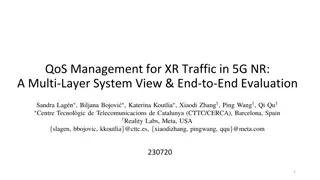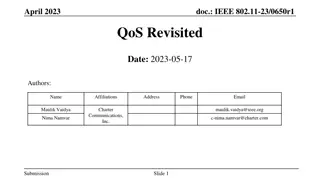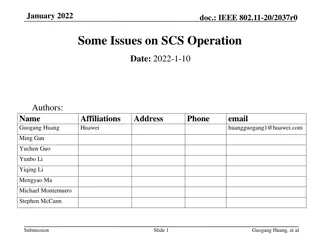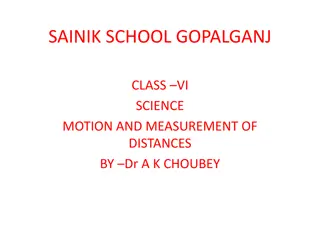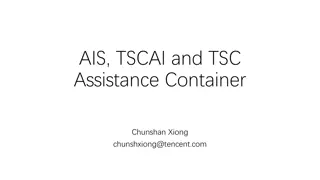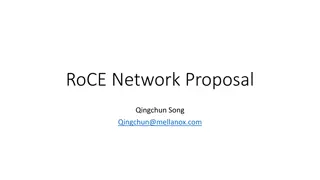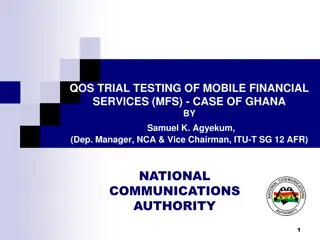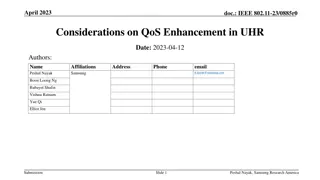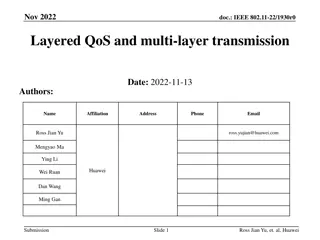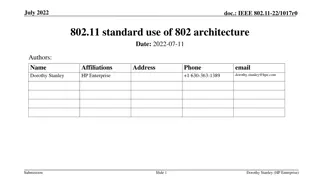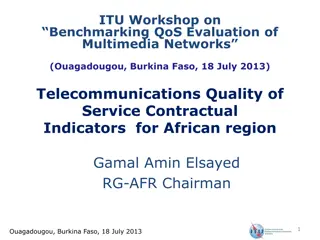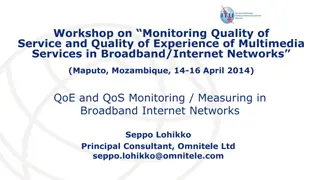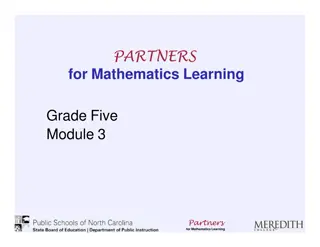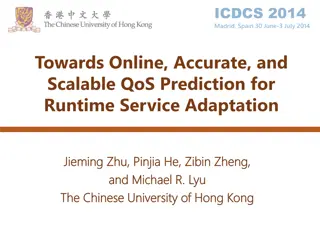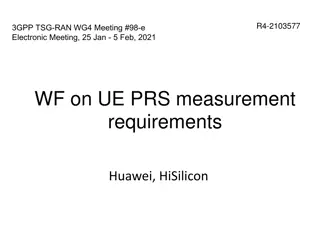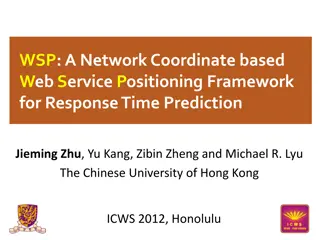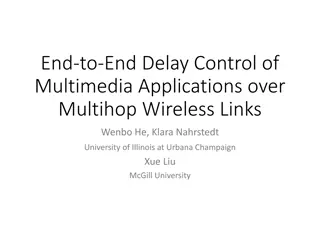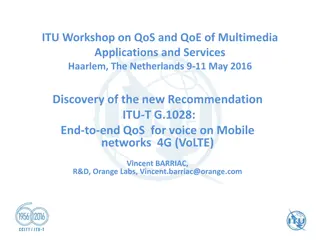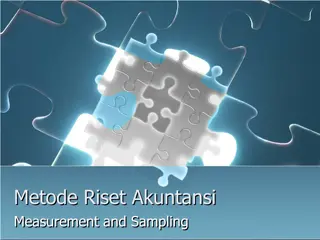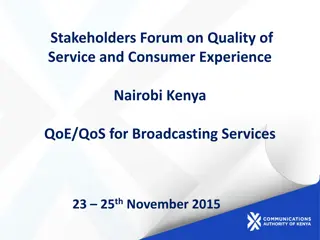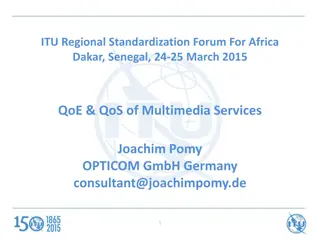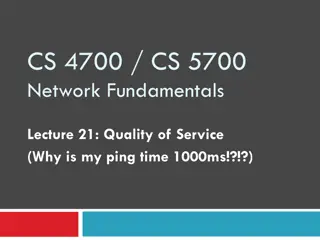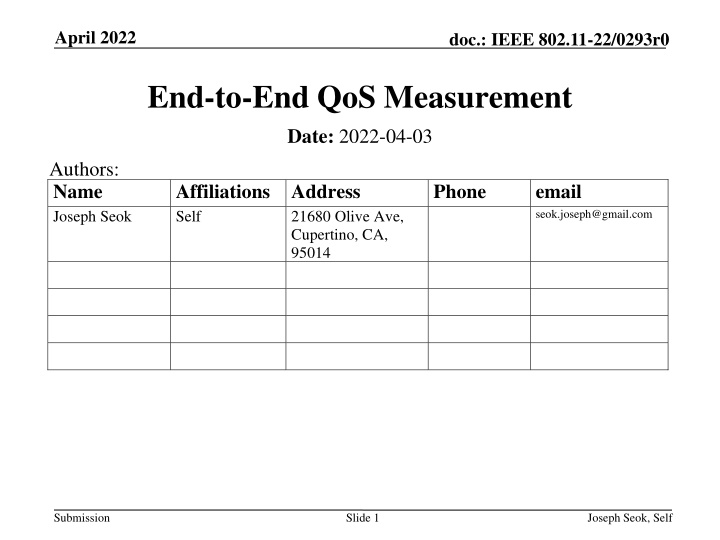
End-to-End QoS Measurement in IEEE 802.11 Networks
Delve into the latest QoS management mechanisms in IEEE 802.11 networks, focusing on Stream Classification Service, Mirrored Stream Classification Service, Restricted Target Wake Time, and more. Explore the considerations for measuring end-to-end QoS in Wi-Fi networks where these mechanisms are deployed.
Download Presentation

Please find below an Image/Link to download the presentation.
The content on the website is provided AS IS for your information and personal use only. It may not be sold, licensed, or shared on other websites without obtaining consent from the author. If you encounter any issues during the download, it is possible that the publisher has removed the file from their server.
You are allowed to download the files provided on this website for personal or commercial use, subject to the condition that they are used lawfully. All files are the property of their respective owners.
The content on the website is provided AS IS for your information and personal use only. It may not be sold, licensed, or shared on other websites without obtaining consent from the author.
E N D
Presentation Transcript
April 2022 doc.: IEEE 802.11-22/0293r0 End-to-End QoS Measurement Date: 2022-04-03 Authors: Name Joseph Seok Affiliations Address Self Phone email seok.joseph@gmail.com 21680 Olive Ave, Cupertino, CA, 95014 Submission Slide 1 Joseph Seok, Self
April 2022 doc.: IEEE 802.11-22/0293r0 Abstract Recently a lot of QoS management mechanisms including the following have been introduced in IEEE 802.11-2020 and IEEE 802.11be. Stream Classification Service (SCS), Mirrored Stream Classification Service (MSCS), Restricted Target Wake Time (r-TWT), Multi-link SCS, Multi-link MSCS. This document discusses the consideration points in the end-to-end QoS measurement procedure, when the QoS management mechanisms are applied to a Wi-Fi network. Submission Slide 2 Joseph Seok, Self
April 2022 doc.: IEEE 802.11-22/0293r0 Recap: Stream Classification Service [1] Submission Slide 3 Joseph Seok, Self
April 2022 doc.: IEEE 802.11-22/0293r0 Recap: Stream Classification Service [1] Submission Slide 4 Joseph Seok, Self
April 2022 doc.: IEEE 802.11-22/0293r0 Recap: Restricted Target Wake Time [2] A latency sensitive traffic stream can be characterized by the following parameterized model: o Bursty, periodic o Traffic amount varies driven by application (e.g. compression) in addition to wireless medium dynamics An application may contain multiple such streams of different parameters Tethered link is a common design to balance computation power, network bandwidth and latency o Require support of peer-to-peer communication XR System Paradigms Example: Submission Slide 5 Joseph Seok, Self
April 2022 doc.: IEEE 802.11-22/0293r0 Recap: Restricted Target Wake Time [2] Existing Protected TWT: TXOPs within TWT SPs shall be initiated with a NAV protection mechanism, such as (MU) RTS/CTS, or CTS-to-self frame. Under this rule: o SP start time may vary if previous transmission didn t finish resulting in unpredictability in delay and increased jitter Propose additional rule: TXOP shall stop before a protected TWT SP starts o Provide a more predictable latency performance: reduce jitter o Reduce wake-up time: additional power saving Restricted TWT: term used in this presentation ACK RTS Data AP CTS BA Low-lat STA 1 Example: Data Data Regular STA 2 Submission Slide 6 Joseph Seok, Self
April 2022 doc.: IEEE 802.11-22/0293r0 End-to-End QoS Measurement Most of the QoS management mechanisms defined in the IEEE 802.11 are applied to the specific traffic stream. o traffic stream (TS): A set of medium access control (MAC) service data units (MSDUs) to be delivered subject to the quality-of-service (QoS) parameter values provided to the MAC in a particular traffic specification (TSPEC). TSs are meaningful only to MAC entities that support QoS within the MAC data service. These MAC entities determine the TSPEC applicable for delivery of MSDUs belonging to a particular TS using the priority parameter provided with those MSDUs at the MAC service access point (MAC SAP). Submission Slide 7 Joseph Seok, Self
April 2022 doc.: IEEE 802.11-22/0293r0 End-to-End QoS Measurement Traffic stream is classified by the traffic classification (TCLAS) filter. o traffic classification (TCLAS): The specification of one of several types of matching filter to classify protocol data units (PDUs) or medium access control (MAC) service data units (MSDUs) as belonging to a particular traffic stream (TS). Depending on the type of classification, the filter is applied within the MAC sublayer management entity (MLME), above the MAC, or within the MAC itself. Submission Slide 8 Joseph Seok, Self
April 2022 doc.: IEEE 802.11-22/0293r0 End-to-End QoS Measurement If the packets (e.g., ICMP packet) that are used by the end-to-end QoS measurement procedure are not classified by the same traffic stream, the measured end-to-end QoS parameter (e.g., latency, throughput) may not represent the accurate QoS level. Submission Slide 9 Joseph Seok, Self
April 2022 doc.: IEEE 802.11-22/0293r0 End-to-End QoS Measurement In the below example, the end-to-end latency measured by the ICMP 1-4 packets may overestimate the actual end-to-end latency value. o This is because the real time packet belonging to the traffic stream on which the QoS management mechanism (like the restricted TWT) is applied can be treated with high priority. High Priority Restricted TWT SP Real Time 4 Real Time 6 Real Time 5 Real Time 3 Real Time 2 ICMP 1 Real Time 1 Low Priority 802.11 link ICMP 4 ICMP 3 ICMP 2 Submission Slide 10 Joseph Seok, Self
April 2022 doc.: IEEE 802.11-22/0293r0 End-to-End QoS Measurement Proposed Solution: o The packets used by end-to-end QoS measurement have to be classified into the same traffic stream. o For this purpose, the STA provides the TCLAS filters for both a real time packet and an end-to-end QoS measurement packet to define the traffic stream. Submission Slide 11 Joseph Seok, Self
April 2022 doc.: IEEE 802.11-22/0293r0 Conclusion Even though various QoS management mechanisms are being developed in IEEE 802.11, an interface between the IEEE 802.11 Station Management Entity (SME) and the application program is not standardized. In order to effectively implement the proposed solution, the application layer should use the interface to provide the packet classification information and the expected QoS parameter for the traffic stream. Submission Slide 12 Joseph Seok, Self
April 2022 doc.: IEEE 802.11-22/0293r0 References [1] Alex Ashley, Stream Classification Service, https://mentor.ieee.org/802.11/dcn/09/11-09-0725-01- 00aa-stream-classification-service-presentation.ppt [2] Chunyu Hu et al., Protected TWT Enhancement for Latency Sensitive Traffic, https://mentor.ieee.org/802.11/dcn/20/11-20-1046-14- 00be-prioritized-edca-channel-access-slot- management.pptx Submission Slide 13 Joseph Seok, Self

